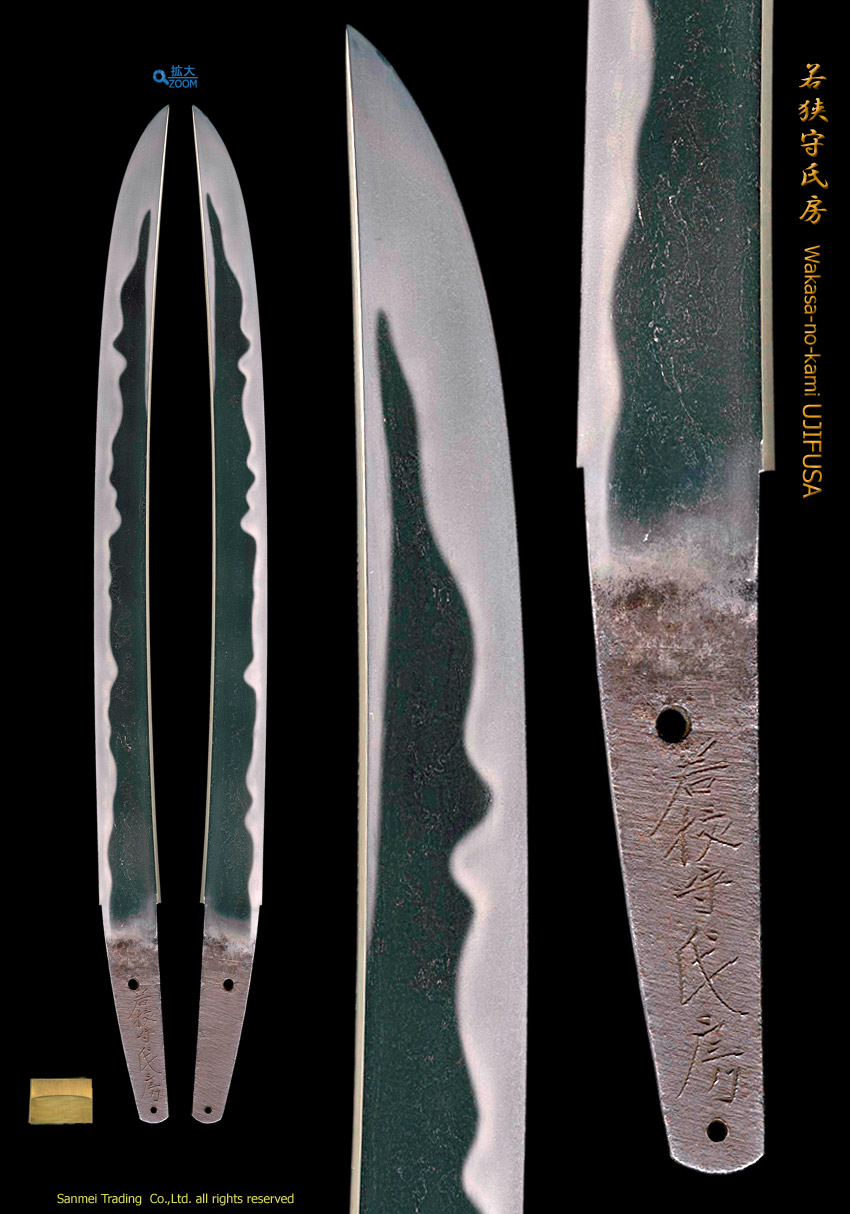Length of cutting edge 41.8cm Curvature 1.0cm Width of base 32.7mm Thickness of base6.5mm
Forging(Hada): Forging is conspicuous Itame and Mokume hada mixing with entwined flowing Masame indication mostly along area of Mune back ridge. The steel is covered with sparkling martensite particles of Ji-nie that glows pronounced thick gleaming lines of Chikei activity.
Temper(Hamon): Hamon is fine Nie hard metal granules base, large waves of Notare and larger roundish elements of Gunome outline mixing with Togari-ha and Clove tassel-shaped Choji. The entire temper outline of both sides are well matched. The boundary line shows some indication of double-temper of Ni-ju-ha and interior is filled with martensite crystals of Nioi in full where short lines of Sunagashi and darkish gleaming line of Kinsen appear. The entire boundary quenching line is sparkling brightly in the bluish fine steel.
Temper of tip(Boshi): Boshi is irregularly Midarekomi into flames up indication then deeply turns back that generates side view of Jizou stone stature.
Tang(Nakago): Nakago is in UBU original. Two peg holes. Sujikai (slanting left) filemarks. Back ridge of Nakago is flat and contoured ridge of the other side. Kurijiri round heel shape. The signature in front is five large character that reads Wakasa-no-kami UJIFUSA 若狭守氏房.
The first smith UJIFUSA 氏房, real name [Kawamura Kyouzaburo 河村京三郎, the initial smith name KANEFUSA 兼房], was born in the 3rd year of Tenbun (1534) as the 3rd son of Seizaemon KANEFUSA 清左衛門兼房 in Gifu, Mino province. He officially was given the way of legitimate son of KANEFUSA 兼房 from his elder brother Iwami-no-kami KUNIFUSA 岩見守国房 in the 2nd year of Kouji (1556) to chage his given name from Kyouzabuto 京三郎 to Seizaemon 清左衛門 then moved to Seki town, Mino province.
In the 19th day, the 4th month, 13th year of Eiroku (1570) he enjoyed the official title of [Kiyozaemon-no-shuoi 清左衛門少尉] and changed his smith name to UJIFUSA 氏房, then 3 days later he got an official district [Wakasa-no-kami 若狭守] title granted by the Imperial Court.
He won the praise from the daimyo Oda Nobunaga to exclusively belong to him. In the 5th year of Tensho (1577) he moved to Azuchi castle town in Oumi province along with Oda Nobunaga to work exclusively as a vassal.
After the Incident at Honnō-ji (本能寺の変, Honnō-ji no Hen) referred to the forced suicide in the 21th day, the sixth month, the 10th year of Tensho (1582) of Oda Nobunaga, UJIFUSA 氏房 was compelled to return back to his home town Gifu with Oda Nobutaka's help then again came back to Kiyosu castle town under support of Sakuma Masakatsu.
Passed away in the 11th day, the 5th month of Tensho (1590) at 57 years old.
This is the prominent work in his prime days Genki-Tensho era (1570-80's) in his forties to fifties, in the peak of Warning States period while Oda Nobunaga decided crucial battle of ANEGAWA, Ishiyama Hongan-ji War and Siege of Mount Hiei.
The top three character of WAKASA-NO-KAMI 若狭守 is a bit on smaller side then the rest for smith name UJI FUSA 氏房 becomes larger, it is one of his peculiar manner in his prime days. Such large Hirazukuri- style wakizashi was designed for fast draw and working well for cutting through the openings of armor or helmet, which was made upon special demand from daimyo Oda Nobunaga himself or his vassal general Samurai in Owari domain then to have been treasured in generations.
Nakago holds a good taste of patina, remains clear filemark and chisel of signature.
Wakasa-no-kami UJIFUSA 若狭守氏房 has been praised as Waza-mono (the best cutting performance) and Jo-jo-saku (above superior made) artistic value.
Gold foiled double habaki collar, preserved in Shira-Saya plain wood mounting
Recent elaborate polish/Condition scale: excellent (using a scale of mint-excellent-very good-good-fair-poor).
reference sword: Katana signed Wakasa-no-kami UJIFUSA-saku The 8th month, 2nd year of Genki (1571)
reference data : Owari Tōkōfu Iwata Atou 1985 Publisher : Nagoya city Board of Education

